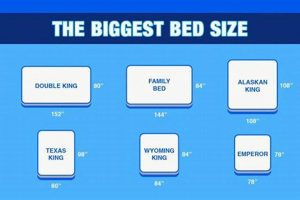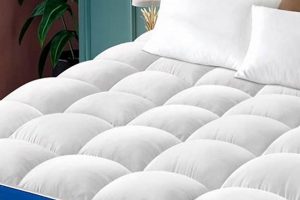Measurements for bedding in the United States typically follow a system using inches. However, understanding the corresponding metric dimensions, specifically centimeters, is valuable for those accustomed to the metric system or when comparing international product specifications. Converting these dimensions allows for precise comparisons and informed purchasing decisions, regardless of the measurement system preferred. For instance, a Queen size mattress, commonly used in the US, has particular length and width measurements which can be accurately represented in centimeters.
The ability to convert these measurements offers several advantages. It streamlines the process of ordering bedding accessories, such as sheets and comforters, from international vendors. Furthermore, it aids in space planning within bedrooms, ensuring that the selected mattress will appropriately fit within the designated area. Historically, the standardization of mattress dimensions has evolved to accommodate varying sleeping preferences and body types, with both inch-based and now, increasingly, centimeter-based specifications being relevant in today’s global marketplace.
This article will provide a detailed overview of standard US mattress dimensions and their equivalent values, explained in centimeters. A convenient conversion chart and key considerations when choosing a suitable mattress will also be presented.
Guidance on Understanding Bedding Dimensions
Accurate comprehension of bedding dimensions is critical when selecting a mattress, especially when dealing with conversions from inches to centimeters. The following points offer guidance to ensure informed decisions.
Tip 1: Prioritize Accuracy in Conversions: Employ reliable conversion tools or references to ensure precise transformation of inch measurements to centimeters. Even minor discrepancies can lead to issues with bed frame compatibility or overall fit.
Tip 2: Consider Frame Compatibility: Mattress dimensions are a critical factor when selecting a bed frame. Verify that the internal dimensions of the frame are appropriate for the mattress dimensions being considered. A bed frame that is too small or too large can lead to instability, reducing the mattress’s lifespan.
Tip 3: Evaluate Room Size: Precisely assess the bedroom dimensions and plan for adequate space around the bed. A clear understanding of mattress size, particularly its centimeter equivalent, allows for optimized room layout, preventing overcrowding.
Tip 4: Account for Bedding Thickness: Memory foam or pillow-top mattresses often exhibit greater thickness than standard mattresses. Factor this additional height into calculations to ensure appropriate bedding depth, especially when purchasing fitted sheets.
Tip 5: Consult Manufacturer Specifications: Always refer to the manufacturer’s data for the most accurate dimensions. Variation can occur even within the same stated size category. Manufacturer-provided specifications are the definitive guide.
Tip 6: Differentiate Between Mattress Types: Different mattress types, such as innerspring or hybrid, may exhibit slight dimensional variances. Investigate the specifications of the specific mattress type being considered to refine dimension estimates.
Tip 7: Confirm International Shipping Standards: If ordering internationally, ensure that the dimensions stated in centimeters comply with relevant shipping restrictions and packaging standards. Non-compliance may cause delivery delays.
Adhering to these guidelines enables a more informed approach to mattress selection. Precise dimension understanding facilitates optimal comfort, extended product lifespan, and a seamless fit within the bedroom environment.
Having addressed these considerations, the next section will outline a specific summary of common mattress sizes.
1. Twin Dimensions
The term “Twin Dimensions” refers to the specific measurements of a twin-sized mattress, a common size within the framework of standard US mattress sizes. Understanding these dimensions, especially their conversion into centimeters, is fundamental for various practical applications, ranging from space planning to cross-border purchasing.
- Standard Measurements and Conversion
A standard twin mattress measures approximately 38 inches wide by 75 inches long. Converting these figures to the metric system yields dimensions of roughly 96.5 cm wide by 190.5 cm long. This conversion is essential for individuals familiar with the metric system or when sourcing bed frames and bedding from countries that primarily use centimeters.
- Applications in Limited Spaces
Twin mattresses are frequently selected for smaller bedrooms, dormitories, or children’s rooms due to their compact size. Knowledge of the centimeter equivalent of these dimensions (96.5 cm x 190.5 cm) is critical when planning furniture placement within a room with limited square footage. Precise measurements prevent overcrowding and ensure functional use of available space.
- Considerations for Bedding Selection
When purchasing bedding accessories, such as sheets and comforters, for a twin mattress, the centimeter dimensions become relevant, particularly when ordering from international suppliers. Understanding that a twin mattress is approximately 96.5 cm wide and 190.5 cm long prevents the selection of bedding that is either too small or excessively large, ensuring a proper fit and optimal comfort.
- Variations in Thickness and Support Systems
While the standard length and width of a twin mattress remain relatively constant, the thickness can vary depending on the type of mattress (e.g., innerspring, memory foam). This variation, when expressed in centimeters, affects the appropriate depth of fitted sheets and the overall height of the bed. Accurate measurements are essential for selecting the right bedding and accommodating any specific needs related to mattress thickness.
In summary, the conversion of “Twin Dimensions” into centimeters serves as a vital tool for informed decision-making. It influences spatial planning, facilitates bedding selection, and ensures compatibility with internationally sourced products, thereby emphasizing the importance of understanding “american mattress sizes in cm” within a global context.
2. Twin XL Length
The term “Twin XL Length” signifies the extended length characteristic of a Twin XL mattress, a specific size within the catalog of standard US mattresses. Understanding this dimensional specification, especially its translation into centimeters, is crucial because it directly impacts the suitability of the mattress for individuals with particular height requirements and influences its compatibility with certain bed frames and bedding. The standard Twin XL mattress dimension is 38 inches wide by 80 inches long. Converted to the metric system, this equates to approximately 96.5 cm in width and 203.2 cm in length. The extended length, in comparison to a standard twin mattress, is the defining feature, influencing its selection for taller individuals or specific institutional settings.
The dimensional difference between a standard Twin and a Twin XL is of considerable practical importance. For example, college dormitories often utilize Twin XL mattresses to accommodate the varying heights of students. The five-inch (12.7 cm) difference in length can be a determining factor in comfort for a taller individual. Incorrectly assuming a standard Twin length when a Twin XL is required leads to discomfort and potentially disrupted sleep. Conversely, using Twin XL bedding on a standard Twin mattress results in excess fabric and a poor fit. Furthermore, accurately understanding the centimeter equivalent of Twin XL Length (203.2 cm) is valuable when sourcing bedding from international suppliers, where metric measurements are the norm.
In summary, “Twin XL Length” represents a critical dimension within American mattress sizes. Its proper understanding, particularly the centimeter conversion, ensures appropriate selection based on individual needs, facilitates accurate bedding purchases, and aids in efficient space planning. The potential challenges arising from misinterpreting this dimension highlight the practical significance of precise measurement and conversion within the context of “american mattress sizes in cm”.
3. Full Width
The dimension “Full Width,” referring to the width of a full-size mattress, holds significant relevance when considered within the framework of “american mattress sizes in cm.” Its understanding is crucial for space planning, bedding selection, and ensuring appropriate comfort for sleepers, especially when metric equivalents are utilized.
- Standard Full Width and Conversion
A standard full-size mattress possesses a width of approximately 54 inches. Converting this measurement to the metric system results in a width of approximately 137.2 cm. This conversion is essential for international comparisons and ensures accurate integration with metric-based bed frames and bedroom layouts.
- Relevance for Couples and Growing Children
The 137.2 cm width of a full mattress often renders it a suitable option for single adults seeking more space than a twin but smaller than a queen, or for couples with limited space. As growing children transition from a twin, a full-size mattress provides a wider sleeping surface. Accurately understanding this centimeter measurement assists in determining the appropriateness of a full-size mattress for specific needs.
- Impact on Room Layout and Furniture Placement
When planning bedroom layout, the 137.2 cm width of a full-size mattress influences the arrangement of other furniture. Precise measurements are essential for ensuring sufficient walking space and preventing overcrowding. Effective space utilization necessitates a clear understanding of mattress dimensions in the metric system.
- Considerations for Bedding Selection
The precise width of a full-size mattress, expressed as 137.2 cm, directly impacts the selection of appropriate bedding. Fitted sheets, comforters, and other bedding accessories must be appropriately sized to ensure a proper fit. The centimeter measurement allows for accurate comparison with international bedding products, ensuring compatibility and preventing mis-sizing issues.
In conclusion, the dimension “Full Width,” when understood within the context of “american mattress sizes in cm,” plays a vital role in various practical considerations. Precise conversion and awareness of the 137.2 cm width facilitate informed decision-making regarding mattress selection, space planning, and bedding procurement. The interplay of these factors emphasizes the value of dimensional awareness in the overall sleeping experience.
4. Queen Popularity
The prominence of the queen-size mattress within the American market directly influences the significance of understanding its dimensions in centimeters. The queen size holds a dominant position, making its metric conversion a widely relevant data point for consumers and manufacturers alike.
- Space Efficiency and Comfort Balance
The queen mattress, typically measuring 60 inches wide by 80 inches long (approximately 152.4 cm by 203.2 cm), strikes a balance between space efficiency and sleeping comfort. This equilibrium renders it a suitable choice for master bedrooms in apartments and smaller homes. Its dimensions, when expressed in centimeters, become critical when planning room layouts and ensuring adequate space around the bed. The popularity stems from this practical versatility.
- Broad Availability and Bedding Options
The widespread preference for queen mattresses results in an extensive array of available options, ranging from innerspring to memory foam and hybrid constructions. This popularity extends to the bedding market, where queen-size sheets, comforters, and other accessories are readily available in diverse styles and price points. Understanding the centimeter dimensions ensures compatibility with both domestic and international bedding products, catering to a broader consumer base.
- Suitability for Couples and Individual Sleepers
Queen mattresses provide ample space for couples, while also offering sufficient room for individual sleepers who prefer more space than a full-size mattress. This dual appeal contributes to its widespread adoption. Knowing the centimeter dimensions allows couples to assess whether the mattress provides adequate personal space, particularly when compared to the more expansive king-size option.
- Impact on Industry Standards and Manufacturing
The queen mattress’s dominant market share has influenced standardization within the bedding industry. Manufacturers commonly design bed frames, foundations, and adjustable bases with queen-size dimensions as a benchmark. Understanding the precise centimeter measurements is therefore essential for ensuring compatibility across different brands and product categories. This standardization further reinforces its popularity by simplifying the purchasing process for consumers.
In conclusion, the significant “Queen Popularity” within the American market underscores the importance of understanding its precise dimensions, particularly in centimeters. From spatial planning to bedding selection and industry standardization, the widespread adoption of the queen-size mattress necessitates a clear comprehension of its metric equivalent for both consumers and manufacturers. The interplay between demand and dimensional awareness reinforces the value of understanding “american mattress sizes in cm”.
5. King's Expansive Area
The term “King’s expansive area” refers to the notably large surface of a king-size mattress, a key component within the range of “american mattress sizes in cm.” The generous dimensions of this size directly impact sleeping comfort, room space utilization, and bedding selection. A standard king-size mattress measures approximately 76 inches wide by 80 inches long. This translates to roughly 193 cm in width and 203.2 cm in length. The magnitude of these dimensions, when converted to centimeters, underscores the significant area occupied by a king-size mattress within a bedroom. For instance, its expansive surface allows for greater separation between sleeping partners, mitigating disturbances caused by movement during the night. However, this benefit is contingent upon adequate room size to accommodate the mattress without overcrowding.
The practical implications of “King’s expansive area” are manifold. Firstly, its considerable width necessitates careful consideration of bedroom dimensions to ensure sufficient clearance around the bed for movement and furniture placement. Secondly, the metric dimensions (193 cm x 203.2 cm) are crucial when selecting appropriate bedding. King-size sheets, comforters, and duvet covers are designed to fit these specific measurements; improper sizing can lead to discomfort and reduced product lifespan. Furthermore, the availability of king-size bed frames and foundations varies depending on manufacturer and retailer, highlighting the importance of verifying compatibility with the mattress’s centimeter specifications. A real-life example is a couple upgrading from a queen-size to a king-size mattress only to discover their existing bedroom is too small, hindering mobility and aesthetic balance.
In summary, understanding “King’s expansive area” is essential when considering “american mattress sizes in cm.” Its significance lies in its direct correlation with sleeping comfort, space planning, and bedding compatibility. Challenges may arise from underestimating the space requirements or neglecting precise centimeter conversions when purchasing accessories. Ultimately, accurate dimensional awareness ensures that the benefits of a king-size mattress, such as increased personal space and reduced sleep disruption, are fully realized within the context of individual needs and bedroom constraints.
6. California King's Length
The dimension of “California King’s Length,” a critical aspect of “american mattress sizes in cm,” requires precise understanding due to its specific application and dimensional characteristics compared to other standard mattress sizes. Its increased length, relative to a standard king, serves a particular demographic need and influences bedroom planning and bedding selection.
- Dimensional Specifications and Conversion
A California King mattress typically measures 72 inches wide by 84 inches long. When converted to the metric system, this equates to approximately 182.9 cm in width and 213.4 cm in length. This extended length is the defining characteristic and a primary reason for its selection, particularly for taller individuals. Accuracy in conversion is essential for space planning and bedding procurement, especially from international sources.
- Target Demographic and Comfort Implications
The increased length of a California King caters specifically to individuals exceeding average height. The additional four inches (approximately 10.2 cm) compared to a standard King mattress provides enhanced comfort by preventing feet from hanging off the end of the bed. This targeted design highlights the importance of considering individual needs when navigating “american mattress sizes in cm.” Failure to account for this length difference results in discomfort and compromised sleep quality for taller individuals.
- Spatial Planning Considerations
While slightly narrower than a standard King, the greater length of a California King necessitates careful spatial planning within the bedroom. The 213.4 cm length dimension dictates appropriate room size and furniture placement. A common error is assuming that a room suitable for a King will automatically accommodate a California King, leading to overcrowding and restricted movement. Accurate measurement and spatial visualization are therefore crucial.
- Bedding Availability and Cost Implications
Bedding specifically designed for California King mattresses, while generally available, may be less common and potentially more expensive than that for standard King sizes. The specialized dimensions require precise fitting to ensure comfort and aesthetic appeal. Ignoring this factor and attempting to use standard King bedding on a California King mattress results in inadequate coverage and compromised aesthetics. The added cost of specialized bedding should be considered when evaluating “american mattress sizes in cm” within a budgetary context.
In summary, the “California King’s Length” represents a significant dimensional variant within “american mattress sizes in cm,” tailored to specific height requirements and influencing spatial planning and bedding selection. Accurate understanding of its metric equivalent, coupled with careful consideration of individual needs and room dimensions, ensures appropriate mattress selection and optimal comfort.
7. Depth variations
Depth variations, relating to mattress thickness, are an essential, yet often overlooked, component of “american mattress sizes in cm.” While length and width define the sleeping surface, depth dictates overall comfort, support, and compatibility with bedding and bed frames. The effect of depth variations on the overall dimensions of a mattress necessitates accurate measurement and consideration to ensure seamless integration into the bedroom environment. For example, a memory foam mattress may exhibit a greater depth than a traditional innerspring mattress of identical length and width, leading to potential issues if the existing bed frame’s side rails are not high enough to adequately contain the mattress. The absence of understanding regarding depth specifications can lead to miscalculations in bed frame compatibility and the selection of improperly sized sheets.
The practical implications of depth variations extend beyond bed frame compatibility. The chosen sheet set must accommodate the specific depth of the mattress. Standard sheet sets are typically designed for mattresses with a depth range of 8 to 12 inches (approximately 20.3 to 30.5 cm). Deeper mattresses, such as pillow-top or hybrid models, may necessitate the purchase of deep-pocket sheets. Failing to account for these variations can result in sheets that are either too tight, causing premature wear and tear, or too loose, creating an uncomfortable sleeping surface. A real-life example involves the purchase of a new pillow-top mattress without realizing its increased depth required specialized deep-pocket sheets, resulting in nightly frustration and the eventual need to repurchase correctly sized bedding.
In summary, depth variations are an integral dimension within the broader context of “american mattress sizes in cm.” Disregarding depth specifications leads to practical challenges related to bed frame compatibility and bedding selection. The key insight is that the three-dimensional nature of a mattress necessitates careful measurement and consideration of all dimensions, not just length and width. A comprehensive understanding, encompassing both traditional dimensions and depth, is crucial for ensuring a comfortable and functional sleeping environment. This understanding mitigates potential issues, promoting informed decision-making and avoiding unnecessary expenditure on mismatched accessories.
Frequently Asked Questions Regarding American Mattress Sizes in cm
This section addresses common inquiries concerning American mattress sizes and their corresponding measurements in centimeters, providing factual and precise information to facilitate informed decision-making.
Question 1: What is the standard conversion factor used to convert inches to centimeters when considering mattress dimensions?
The standard conversion factor is 2.54 cm per inch. Therefore, multiplying any dimension in inches by 2.54 provides its equivalent in centimeters. Accuracy in this conversion is crucial for precise comparisons and measurements.
Question 2: Do mattress manufacturers typically provide dimensions in both inches and centimeters?
While some manufacturers may include both inch and centimeter measurements, it is not universally practiced. Consumers may need to perform the conversion independently, ensuring accuracy through reliable conversion tools.
Question 3: How significant are minor variations in mattress dimensions, and do these variations impact bedding fit?
Even minor variations, such as a centimeter or two, can affect the fit of sheets and bed frames. It is prudent to check the manufacturer’s specifications and account for any discrepancies to ensure compatibility.
Question 4: Are international mattress sizes directly comparable to American mattress sizes when using centimeter conversions?
Direct comparisons based solely on centimeter conversions can be misleading. International mattress sizes often adhere to different standards and may not precisely align with American sizes, even when expressed in the same unit of measurement. It is advisable to review detailed specifications and potentially consult size charts to ensure a proper fit.
Question 5: What considerations apply when purchasing bedding from international suppliers based on centimeter dimensions?
When buying bedding from international suppliers, careful attention must be given to the specific centimeter dimensions listed. Verify that the dimensions of sheets, comforters, and other accessories precisely match the mattress dimensions. Always consult size charts and, when possible, contact the supplier to confirm compatibility.
Question 6: How does mattress depth, when measured in centimeters, influence the selection of fitted sheets?
Mattress depth, also referred to as thickness, is a critical factor in fitted sheet selection. Standard sheets may not adequately fit deeper mattresses. It may be necessary to purchase deep-pocket sheets designed to accommodate the increased mattress depth.
In summary, understanding the intricacies of “american mattress sizes in cm” necessitates careful attention to conversion accuracy, awareness of potential dimensional variations, and consideration of international standards. Precise measurement and informed decision-making are paramount to ensuring a compatible and comfortable sleep environment.
Having addressed these frequently asked questions, the next section will delve into resources.
American Mattress Sizes in cm
This exploration of the dimensions of American mattresses, translated into centimeters, underscores the necessity for precise measurement in a global marketplace. From spatial planning and bedding procurement to ensuring comfort and compatibility, a thorough understanding of “american mattress sizes in cm” facilitates informed consumer decisions. Consideration of length, width, and depth variations, coupled with accurate conversion practices, mitigates potential challenges arising from disparate measurement systems and international sourcing.
The relevance of these dimensional specifications will likely increase as globalization expands consumer access to international products. It is imperative to prioritize accuracy and utilize reliable conversion tools to ensure seamless integration of bedding and bedroom furniture. By embracing dimensional awareness, consumers can optimize their sleep environments and maximize the utility of their purchases. Continued attention to these details will empower individuals to navigate the complexities of mattress selection with confidence.







